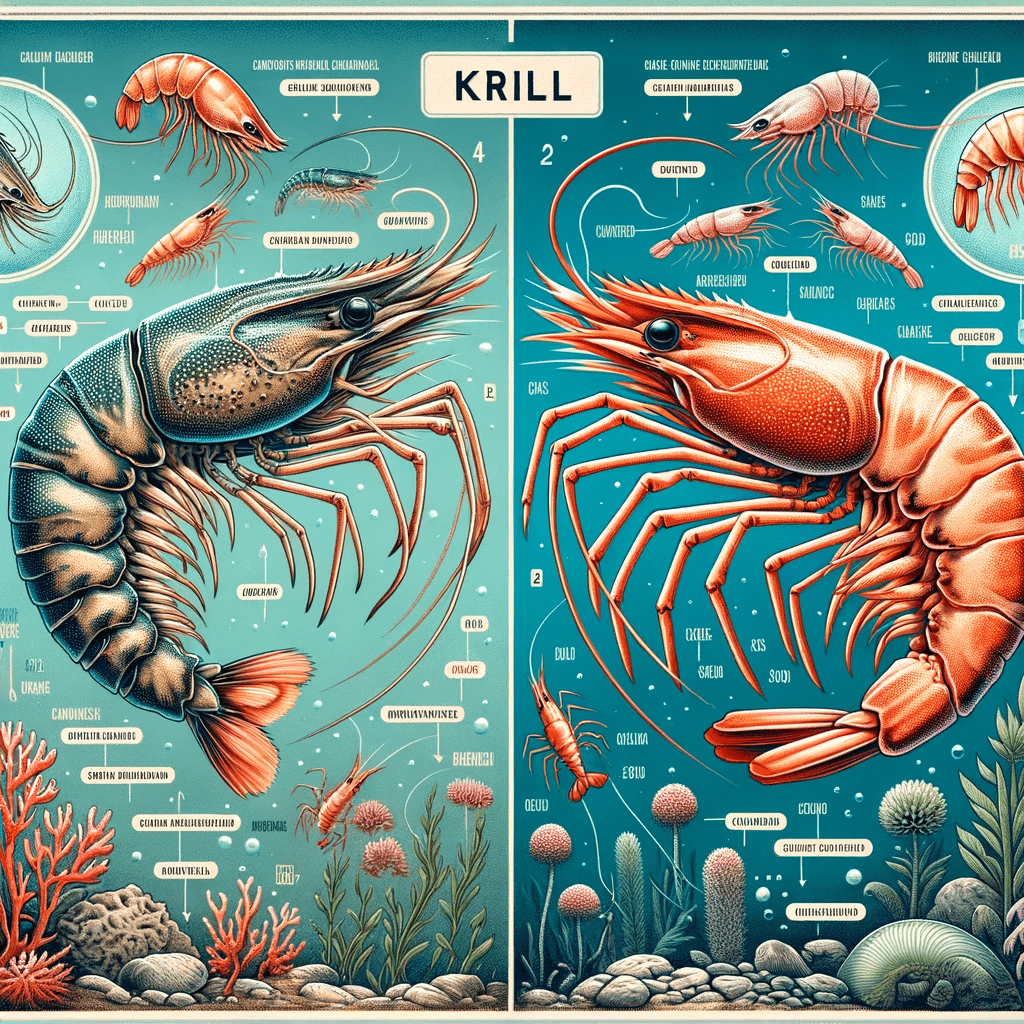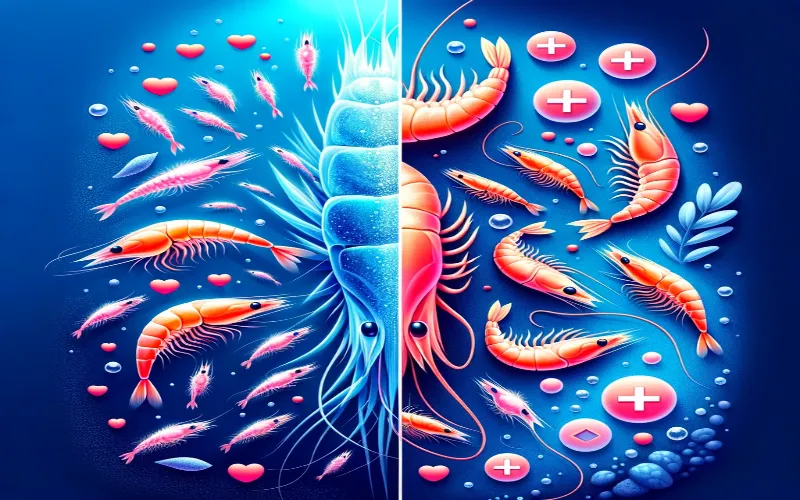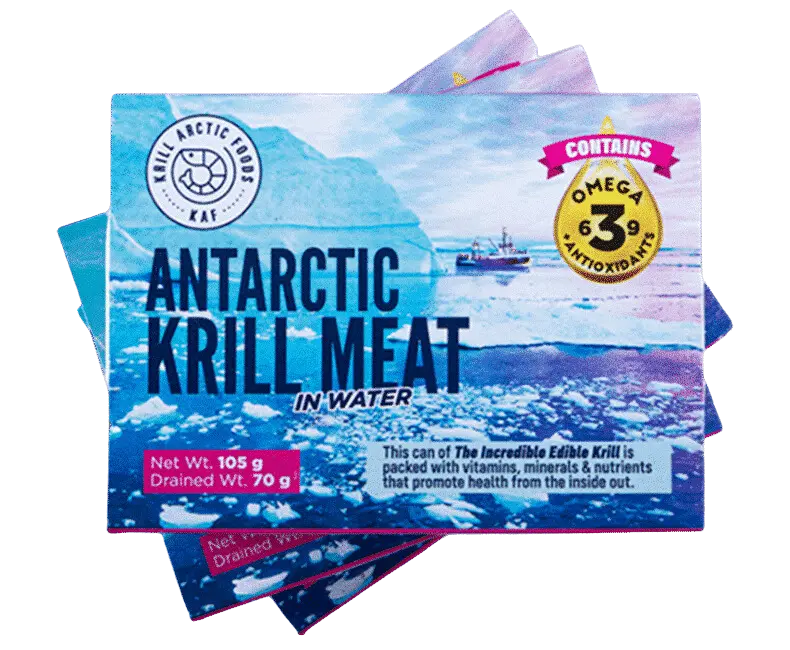- Home /
- Krill vs Shrimp: Understanding the Differences and Benefits

Posted On:January 24th, 2024
Krill vs Shrimp: Understanding the Differences and Benefits
If you have been in the health food and seafood scene, chances are you’ve heard about krill and shrimp. These tiny sea creatures pack an impressive nutrient punch and are celebrated for their potential health benefits. But how do they stack up against each other?
Dive with us beneath the surface as we dissect the nutritional profiles of krill and shrimp to help you navigate the waters of these superfoods, letting you make informed decisions for your wellness journey. Are you ready to dive deep into this oceanic nutrition face-off? Let’s decode the sea’s mysteries and see who emerges victorious from this battle—krill or shrimp.
Key Takeways
Krill and shrimp are both crustaceans, but they have distinct differences. Krill are typically smaller, with a transparent exoskeleton and pink spots. Conversely, shrimp are larger and more colorful, often with red, pink, or light brown hues. Additionally, krill primarily eat algae and phytoplankton, while shrimp have a more varied diet, including algae, small fish, plankton, and aquatic plants.
Krill Vs. Shrimp: Comparing Physical Characteristics
Krill and shrimp are quite different in appearance and physical characteristics, although they are both small crustaceans. While both species possess hard exoskeletons that provide a means of defense from predators, their anatomy varies significantly.
- There are significant disparities in species volume, with around 85 known species of krill compared to a whopping 1,900 shrimp species.
- Size also differs between these two aquatic creatures. Krill typically grow between 0.8 and 2.4 inches and weigh about 0.07 ounces. In contrast, shrimp can reach up to about 10 ounces in weight and have a length of 9.8 inches.
- The diet of these two creatures also diverges: While krill primarily consume algae, phytoplankton, and single-celled plants, shrimp have a more diversified diet of algae, small fish, plankton, and various aquatic plants.
Size and Morphology
- The most obvious physical difference between krill and shrimp is their size. Krill are generally much smaller than shrimp, with most species ranging between 0.8 inches to 2.4 inches in length and weighing about 0.07 ounces. In comparison, shrimp can grow up to 10 ounces in weight and have a maximum length of around 9.8 inches.
- Another key difference in morphology lies in the structure of their bodies. Krill have three body segments – cephalothorax, pleon, and tail fan – with two antennae, complex compound eyes, and six to eight pairs of legs used mainly for swimming. In contrast, shrimp have two body segments – cephalothorax and abdomen – and two pairs of antennae, compound eyes, and ten legs arranged into five walking and five swimming legs.
- A unique characteristic that sets krill apart is their transparent exoskeleton adorned with pink spots that enable them to blend effortlessly into their surroundings, making it difficult for predators to spot them. Conversely, shrimp are bright and colorful; they often come in varying shades of red, pink, or light brown hues that serve as a warning to predators.
- Both species occupy different niches within the marine ecosystem. Krill typically inhabit colder waters around Antarctica or the oceans surrounding Japan, while shrimp prefer warmer estuarine environments in freshwater or saltwater.
Ecosystems and Habitats
Krill and shrimp are small aquatic creatures crucial in the marine food chain.
- Krill belongs to the order Euphausiacea and is found in cold ocean waters, primarily in the Southern Ocean. Antarctic krill live in large swarms near the water’s surface, feeding on phytoplankton.
- On the other hand, shrimp belongs to the order Decapoda and can be found in various habitats ranging from freshwater to deep sea trenches. These habitats include rivers, estuaries, coral reefs, salt marshes, and seafloors.
- The Arctic shrimp, for example, is found under ice-covered waters where it can survive temperatures below -2°C.

Nutritional Analysis: Krill vs. Shrimp
Both krill and shrimp have impressive nutritional profiles that make them ideal for human consumption.
- Krill is rich in omega-3 fatty acids such as EPA (eicosapentaenoic acid) and DHA (docosahexaenoic acid), high in protein, and contains vitamins A, B1, B2, B6, C, and E. It also has phosphorus, magnesium, iron, and zinc minerals that aid bone health.
- In contrast, shrimp is an excellent low-calorie source of micronutrients and macronutrients, such as vitamin B12, that support brain function. It also contains selenium, which helps protect cells against oxidative damage while boosting immunity.
However, one area where these two differ is their cholesterol level. Shrimp contains a relatively high amount of cholesterol per serving size.
| Nutrient Content (Per 3 Oz.) | Krill | Shrimp |
| Calories | 80 | 84 |
| Protein (g) | 14 | 18 |
| Omega-3 Fatty Acids (g) | 0.5 – 1 | < 0.5 |
| Cholesterol (mg) | 70 | 166 |
| Vitamin B12 (mcg) | 45 | 1.2 |
| Iron (mg) | 1 | .7 |
Macro and Micronutrients
Krill and shrimp are both seafood, but they differ in terms of nutritional content.
- Shrimp contains more calories per serving than krill (85 versus 40), making it less ideal for those watching their weight. However, shrimp have a significantly higher protein percentage (24% versus 14%), which is excellent for building and repairing muscle tissue.
- Conversely, krill has fewer essential amino acids compared to shrimp. In terms of micronutrients, krill tends to pack a more significant punch. For instance, krill is richer in vitamin E, vitamin A, and choline – essential nutrients that support proper body development and growth.
Health Benefits and Risks
There are several health benefits and risks of krill vs shrimps.

Health Benefits
- Krill is an excellent source of omega-3 fatty acids, vital components that support brain function and heart health and reduce inflammation.
- Krill oil is distinctive because it comprises phospholipids and omega-3s in one package. Phospholipids aid the effective transport of omega-3s into the bloodstream.
- While less research exists on the health benefits of krill oil compared to fish oil, krill may help alleviate menstrual discomfort symptoms such as bloating and mood swings and reduce inflammation levels in arthritis patients.
- Shrimp is also a rich source of nutrients like vitamin D, niacin, selenium, and zinc but tends to have much fewer omega-3 fatty acids that have substantial clinical effects linked to disease prevention.
Risks
- The downside to consuming large quantities of shrimp due to its high cholesterol levels is that it’s not particularly healthy for individuals with conditions like diabetes or high blood pressure.
- While consuming shrimp and krill is generally safe for most people, adverse effects may occur when consumed in moderation for long-term usage of supplements containing krill oil. Side effects like bad breath, diarrhea, nausea, and gastrointestinal discomfort have been reported in individuals supplementing with high doses of krill oil. Krill oil supplements should be avoided for underlying medical conditions or when taking certain medications. For example, individuals currently under medication such as blood thinners, diuretics, and aspirin would want to steer clear from taking krill oil supplements as they could negatively interact with them.
- While shrimp krill are likely beneficial for health in moderate quantities, the question of sustainability often arises. As both are considered primary food sources for ocean-dwelling creatures like whales and seals, overfishing may considerably threaten their population. The seafood industry must balance meeting demand while maintaining ecosystem sustainability.
Omega-3 Fatty Acids and Heart Health
Heart disease is one of the leading causes of death worldwide, with unhealthy diets playing a significant role. That’s where the benefits of omega-3 fatty acids come into play. Both krill and shrimp are excellent sources of omega-3s.
These essential fatty acids have been shown to reduce blood pressure, decrease inflammation, and improve overall heart health. However, studies suggest that krill oil may be more effective than fish oil in increasing the “good” HDL cholesterol while reducing triglycerides.
Usages in Culinary Roles and Animal Diets
Shrimp and Krill are both common culinary staples worldwide. Krill oil is an excellent replacement for conventional fish oils in cooking due to its high absorption rate among omega-3 supplements. It’s also commonly used as a food supplement or ingredient in animal feeds for domesticated pets or farm animals.
One important feature differentiating krill from shrimp is its sustainable sourcing and harvesting practices. Krill fisheries are considered some of the most sustainably managed fisheries available today.
| Nutrient Content | Krill | Shrimp |
| Protein | 63 grams | 25 grams |
| Calories | 363 | 99 |
| Fat Content | 17 grams | 1 gram |
| Omega-3 Fatty Acids | 1500mg | 450mg |
To put things into perspective, krill contains three times more omega-3 fatty acids than shrimp per gram. Both shrimp and krill remain valuable sources of nutrition with distinct differences in flavor profiles, nutrient compositions, and ecological footprint. Making informed choices contributes to our well-being and helps preserve our environment for future generations.
Role in the Oceanic Food Chain
Krill and shrimp are essential links in the food chain of the world’s oceans, with each playing a vital role. Krill, often called the “foundation species,” supports many other animals, including some of the world’s largest marine mammals, such as whales.
- Their primary food source is phytoplankton, abundant in oceanic waters. Shrimps are also important players in the ocean’s ecosystem, providing an essential food source for many larger fish species like tuna and salmon. Krill and shrimp have significant nutritional value, making them an excellent food choice for people.
- The role of krill and shrimp in maintaining a healthy oceanic ecosystem cannot be overstated. These animals provide habitat and nourishment for a broader range of marine life, ultimately sustaining the lives of numerous other aquatic species. However, excessive fishing or harvesting can threaten their existence and damage ecosystems. For example, declining Antarctic krill populations could have catastrophic effects on some of the world’s most famous sea life inhabitants, like penguins and seals, who rely on krill for food.
Overall, recognizing the importance of these keystone species and investing in sustainable harvesting practices is critical to ensuring their continued presence in our oceans and our diets.
Related Posts
Shop
Products You May Like
Lorem Ipsum is simply dummy text of the printing and typesetting industry
m Ipsum is simply dummy text of the printing and typesetting industry.






